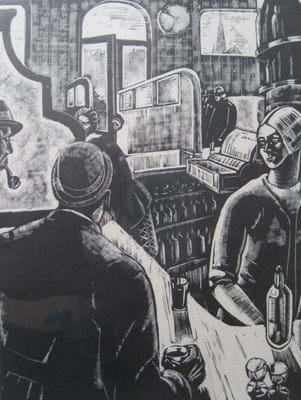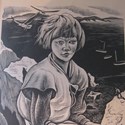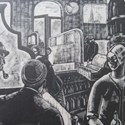One major source of material has been the Grosvenor School of Modern Art prints now soaring in value from artists such as Sybil Andrews, Cyril Power and Lill Tschudi. They were students at this private art school established by Scottish wood engraver Iain MacNab in his house at 33 Warwick Square, Pimlico, London, and run jointly with Claude Flight from 1925-30.
An exhibition about to open at the Ditchling Museum of Art + Craft highlights the work of one of the lesser-known Grosvenor artists: wood engraver Guy Malet (1900-73).
This mini-retrospective in East Sussex is part of a larger show called New Truth to Materials: Wood from September 9-January 1, 2018.
A chance to buy original Malet engravings from the 1930s accompanies the exhibition (see photos above). He went on making prints in the same sort of style almost up until his death.
Prolific artist
Malet followed the tradition of British artists who were drawn to wood as a means of engraving their designs and was prolific, particularly in the period between the two world wars.
Emerging from the Grosvenor school as one of their most skilled printers, he maintained a lifelong friendship with his wood engraving tutor MacNab. He also produced many modernistic linocuts during his time at Grosvenor, but it was for his work with engravings and his mastery of composition that he became best known.
In a 1941 article for The Artist, Malet described why he was drawn to the technique: “To me, the attraction of this medium lies in its definite quality, the strong patterns of black, grey and white one is able to achieve, and the variety of surface pattern obtainable by the use of the various engraving tools.”
James Trollope, a former BBC journalist, is co-curator of this Malet display. He is interested in British printmaking between the wars and has written monographs on Eric Slater (1896-1963) and a more recent one of Arthur Rigden Read (1879-1955).
He told ATG: “Malet is another print-maker who caught my eye partly because he lived for a time in my hometown of Seaford (also Slater’s hometown) and also because I’m interested in wood engraving. I enjoy researching neglected artists whose work I like and then looking for ways (exhibitions, books, articles) to revive interest in their work.
“Malet went on to live in Ditchling, which is why I was able to interest the museum there in a small retrospective of his engravings which date from the 1930s-60s. They are all originals in editions of 50 or fewer (made by him during his lifetime).“
Printmaking tradition
Ditchling has a tradition of printmaking – with the controversial but supremely talented Eric Gill as a leading figure - and Malet had an exhibition there in 1965.
His talent saw him elected to the Royal Society of British Artists in 1935, followed by membership to the Society of Wood Engravers in 1947. Malet was a frequent visitor to Eric Drake’s colony of artists on the island of Sark (also see woodcut pictured above), and became well known for his 1930s railways posters.
His final years were spent living in Ditchling, and the subject matter for his beautiful engravings often reflects the stunning local Sussex landscape.









